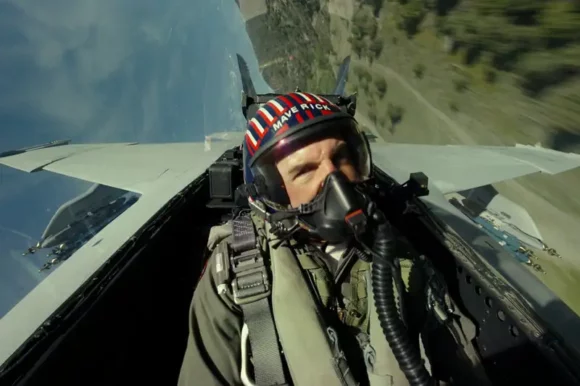Watching Joseph Kosinski’s Top Gun: Maverick, for New Scientist, 8 June 2022
Near the climax of Joseph Kosinski’s delirious sequel to 1986 hit Top Gun, a fifth-generation fighter engages Pete “Maverick” Mitchell’s F/A-18 in a dogfight around vertiginous snow-capped mountains. Suddenly this huge, hulking, superpowered wonderplane banks, stalls and turns, hanging over Mav (Tom Cruise, even more steely-eyed than usual) and his wingman Rooster (Miles Teller) as though it’s painted itself on the sky.
“What the ____ was THAT?” Rooster cries, though an actual graduate of TOPGUN (official name, the Navy Strike Fighter Tactics Instructor program) would probably know a Herbst manoeuvre when they saw one.
The Herbst (also known as a J-turn) is the kind of acrobatic manoeuvre you can pull only if you’re flying one of a handful of very expensive fighters designed and built since 2010. The Russian Sukhoi Su-57 is one such; China has the Chengdu J-20.
We’re not told which aircraft — or indeed, what well-provisioned rogue state — Mav is up against here, but he is in trouble: his F/A-18 multirole combat jet is no slouch, but, being a child of the 1990s, it is neither super-stealthy nor supermanoeuvrable.
“Fifth-gens” are not the only nemesis Mav must confront. He’s also holding out against progress, personified by a rear admiral nicknamed the Drone Ranger who (in a splendidly sour cameo by Ed Harris) declares that drones are the future, and that carrier-based fighter pilots like Mav are dinosaurs.
Most of the time, however, Maverick steers clear of ideas, and devotes itself wholly to 1980s nostalgia, as Tom Cruise’s Pete Mitchell (now a test pilot) sets about making his peace with the orphaned son of his old wingman Nick “Goose” Bradshaw. This is a well-told tale of misunderstanding and redemption, interspersed throughout with one-liners and easter eggs for fans of the earlier film. In one touching and funny scene, Mav gets to thank Ice (now, God help us all, commander of the U.S. Pacific fleet) for keeping him in fighter planes and out of promotion. Of Kelly McGillis’s Charlie, Mav’s love interest in the first movie, there is no mention — but not every storyline can look back, and in this film, Mav’s old flame Penny Benjamin (Jennifer Connelly) proves no pushover.
This is a peculiar project: part war film (as our heroes steal a plane from under the noses of the enemy), part techno-thriller (as Mav the test-pilot breaks all speed records and reaches an insane 3.5km a second), and part sports movie (as Mav welds his brilliant TOPGUN pupils into a world-peace-saving team; by that measure, mind you, you could argue that all Hollywood blockbusters are sports movies at heart).
Films can be good fun-fair rides quite as much as they can be good dramas, and it would be silly to criticise this thrilling display of real-world aeronautical stunt work for its lack of narrative realism. The presence of real planes and real pilots (and, after three months’ training, real airborne cast-members) makes this, in a profound sense, about as realistic a film as it is possible to get.
What we might look forward to eventually, though, is a film that looks for excitement, peril and heroism in a more contemporary theatre, featuring aerial combat that’s truly fifth-generation: super-stealthy, super-manoeuvreable, and drone-enhanced.
Until someone makes that imaginative leap (and, crucially, can take a huge global audience along for the ride), we can expect armed-forces movies to draw more and more on science fiction for their plots. Why is the pilot dog-fighting with Mav and Rooster dressed like an Imperial TIE-fighter pilot from Star Wars? Why is the illegal uranium enrichment plant that’s the target of Mav’s raid equipped with a two-metre wide exhaust vent lifted from Star Wars’s Death Star? Because this is what science fiction is, much of the time: a filler, a place-holder, a hoarding that reads, “Coming soon: the future”.

